
Freyer's pug is a moth of the family Geometridae. The species can be found in Europe, east to the Urals, the Russian Far East, Kazakhstan and China. It is also found in North America.
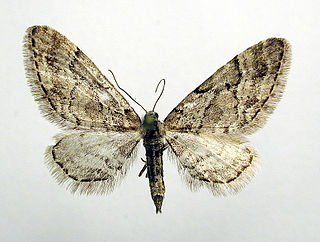
Eupithecia lanceata is a moth of the family Geometridae. It is known from most of the Palearctic realm, except for the south. The habitat consists of pine forests.
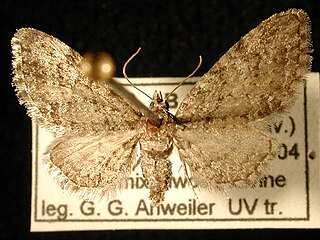
Eupithecia columbiata is a moth in the family Geometridae first described by Harrison Gray Dyar Jr. in 1904. It is found in North America from eastern Newfoundland and Labrador to Vancouver Island, south to North Carolina in the east and Colorado in the west.
Eupithecia undata is a moth in the family Geometridae first described by Christian Friedrich Freyer in 1840. The North American Moth Photographers Group lists it as a synonym of Eupithecia lafontaineata. It is found in the Pyrenees, Alps, the Massif Central, the Tatra mountains, on the Balkan Peninsula and in Romania. It is also found in North America, where it has been recorded from Wyoming, Montana, Idaho, Colorado, Nevada and Oregon.

Eupithecia ericeata is a moth in the family Geometridae first described by Jules Pierre Rambur in 1833. It is found in most of southern Europe and the Near East.
Eupithecia casloata is a moth in the family Geometridae first described by Harrison Gray Dyar Jr. in 1904. It is found in North America, including Yukon, British Columbia, Alberta, Saskatchewan, New Brunswick, Newfoundland and Labrador, Quebec, Washington, Montana, Oregon, Wyoming, Colorado, Utah, California, Maine and New Hampshire.

Eupithecia nimbicolor is a moth in the family Geometridae first described by George Duryea Hulst in 1896. It is found in North America from eastern Newfoundland and Labrador to western British Columbia and from Alaska to Arizona.
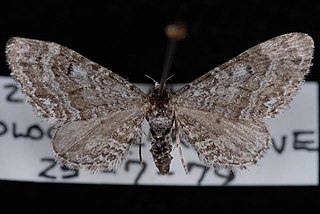
Eupithecia perfusca is a moth in the family Geometridae first described by George Duryea Hulst in 1898. It is found in western North America.
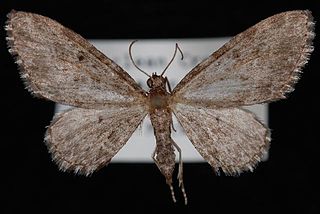
Eupithecia lachrymosa is a moth in the family Geometridae first described by George Duryea Hulst in 1900. It is found in North America from central Saskatchewan west to southern Vancouver Island, north to British Columbia and Alberta and south to California.
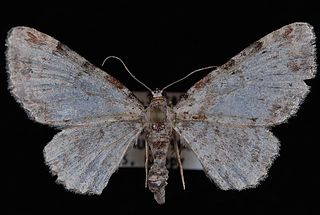
Eupithecia mutata, the spruce cone looper or cloaked pug, is a moth in the family Geometridae. The species was first described by Pearsall in 1908. It is found in the northern Atlantic and New England states in North America. In Canada, the range extends from Nova Scotia to northern Ontario.
Eupithecia hohokamae is a moth in the family Geometridae first described by Frederick H. Rindge in 1963. It is found in the United States in southern Arizona and California.
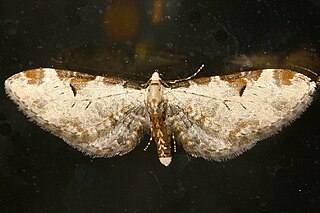
Eupithecia nevadata is a moth in the family Geometridae first described by Alpheus Spring Packard in 1871. It is found in western North America.
Eupithecia sabulosata is a moth in the family Geometridae first described by James Halliday McDunnough in 1944. It is found in the US state of California.

Eupithecia placidata is a moth in the family Geometridae first described by Taylor in 1908. It is found in western North America from British Columbia south to California.
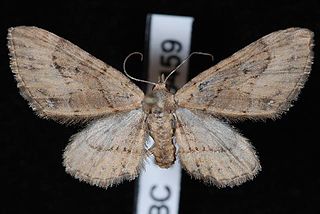
Eupithecia unicolor is a moth in the family Geometridae. It is found from British Columbia south to California.
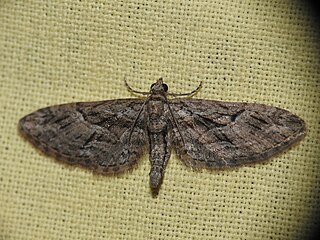
Eupithecia oxycedrata is a species of moth in the family Geometridae. It is found in Spain, southern Portugal, the Balearic Islands, southern France, Corsica, Sardinia, Sicily, Malta, Italy, Slovenia, Croatia, Bosnia and Herzegovina, Montenegro, North Macedonia, Bulgaria, Greece, Crete, western Romania and the Crimea. It is also found in North Africa, from Morocco to Tunisia, and in Turkey. The habitat consists of dry maquis, especially where junipers grow.
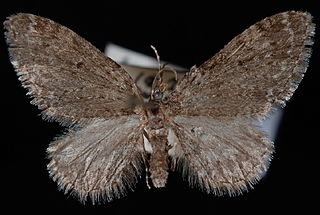
Eupithecia annulata, the larch pug moth, is a moth in the family Geometridae. The species was first described by George Duryea Hulst in 1896. It is found in North America from British Columbia north to the Yukon, east to Newfoundland and Labrador and south to California and Colorado.

Eupithecia spermaphaga is a moth in the family Geometridae first described by Harrison Gray Dyar Jr. in 1917. It is found in western North America from British Columbia, through Oregon and Washington to Nevada and California.
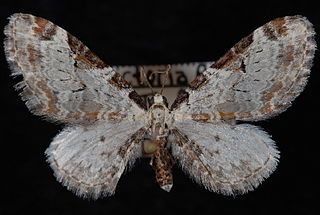
Eupithecia ravocostaliata, commonly known as the tawny eupithecia or great variegated pug, is a species of moth in the family Geometridae. The species was first described by Alpheus Spring Packard in 1876. It is found in northern New York and the New England states, extending across Canada from the Maritime provinces to Vancouver Island and down the west coast as far as the San Francisco Bay region.
Prorella irremorata is a moth in the family Geometridae first described by Harrison Gray Dyar Jr. in 1923. It is found in the United States in the desert regions of southern California, Nevada and Arizona.















